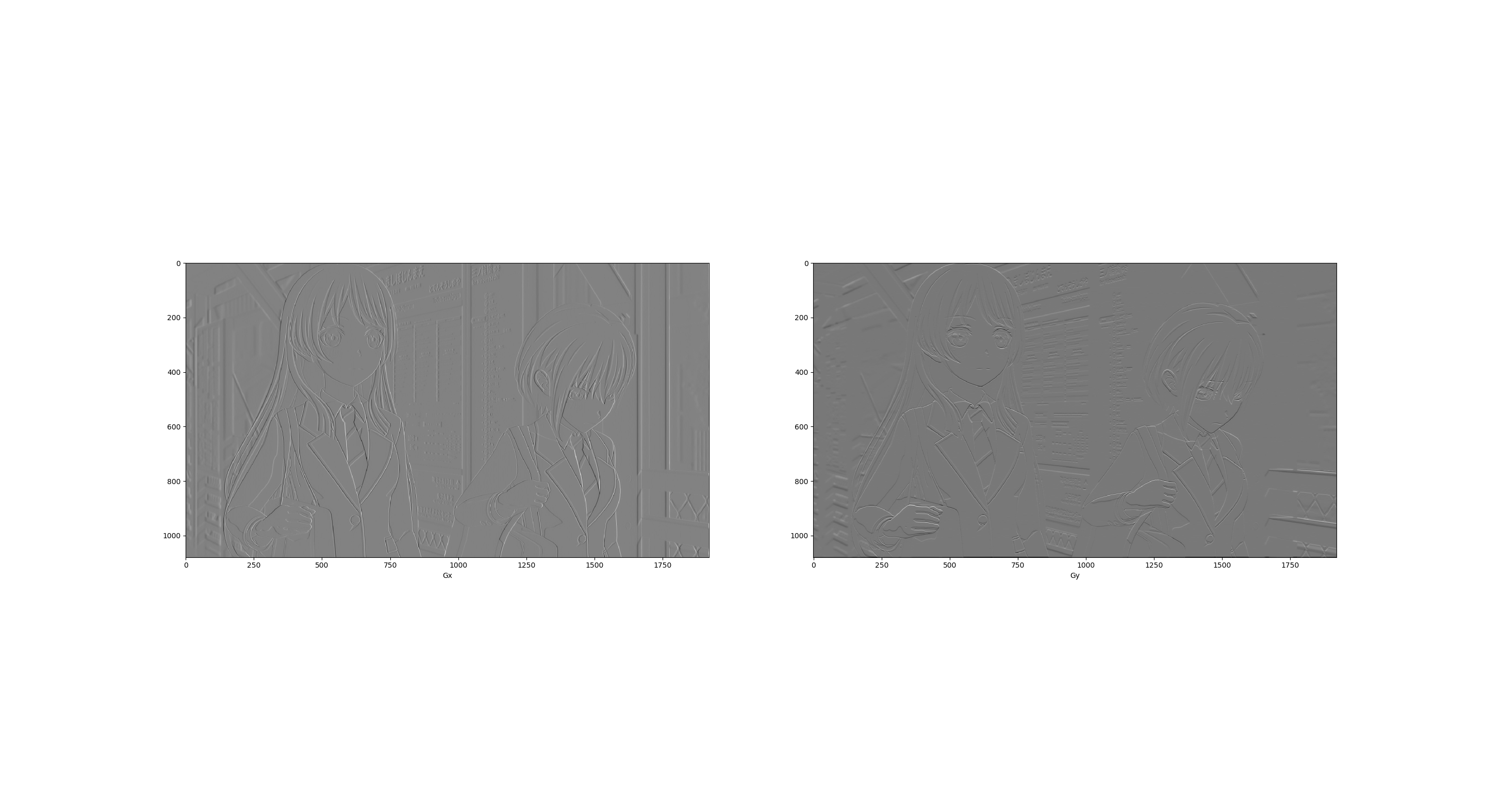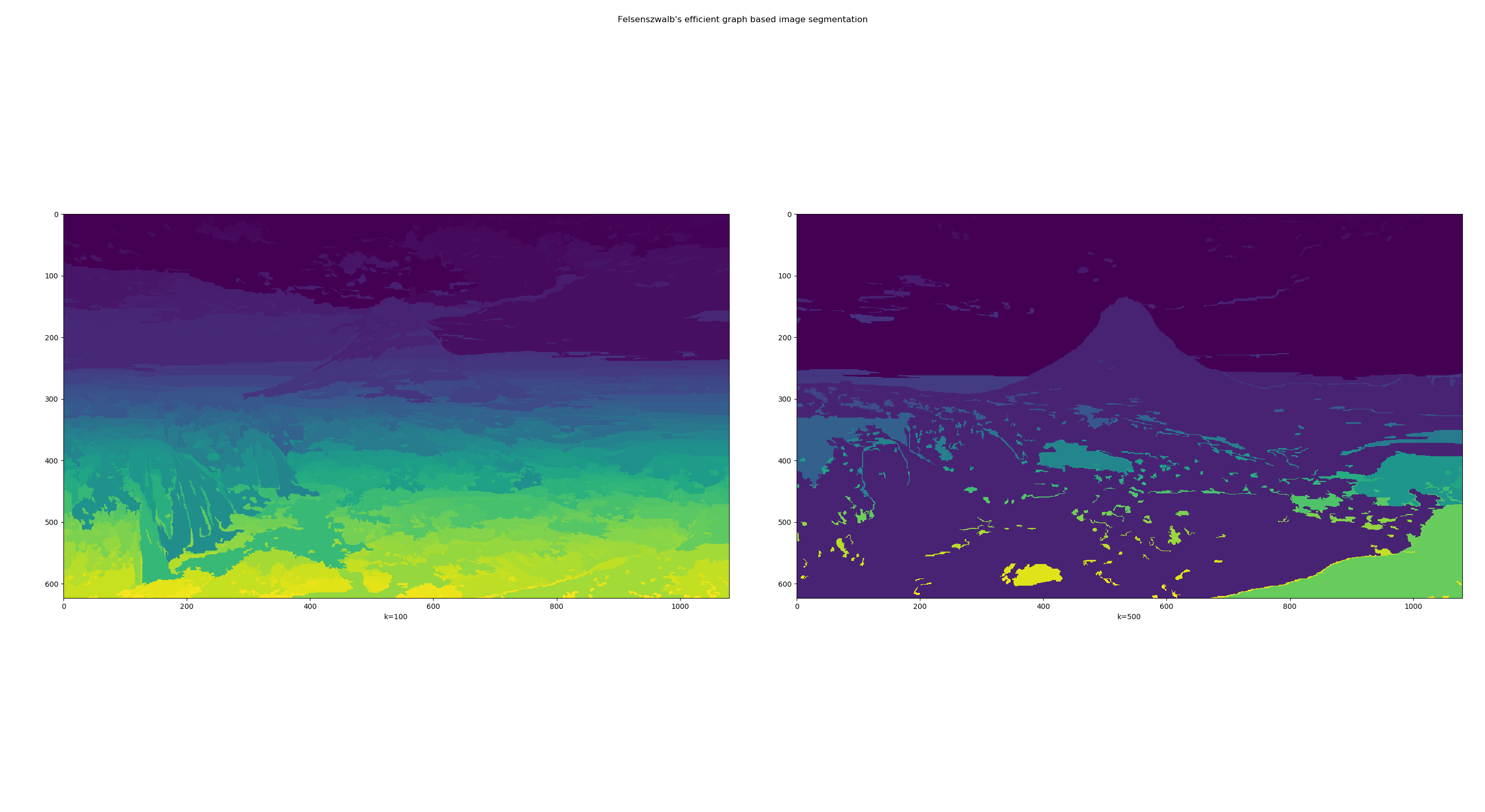TechBlog 1
Basic intro and experiment of CV
In this blog, a simple CV process will be applied for object detection. From a basic image gradient vector, followed by image segmentation, and finally an example of object detection using VGG.
Image Gradient Vector
- Gradient: The direction of gradient is the greatest change rate of the function, which is used to find the extremum.
Image Gradient Vector: Take the image as a function, gradient can be used to measure the pixel‘s change rate. Image gradient can be regarded as a two-dimensional discrete function, and image gradient is actually the derivative of this two-dimensional discrete function
. Take the Sobel operator for an example, which mainly used for edge detection, is a discrete difference operator used to calculate the grayscale approximation of the image gradient function.
Calculation for an image
- Image Process Example: here using an example to see the difference between applying
and to process image pixel.
The example image is:
Code for this:The result shows the comparation of using1
2
3
4
5
6
7
8
9
10
11
12
13
14
15
16
17
18
19
20
21
22
23
24
25import numpy as np
import scipy
import scipy.signal as sigs
import matplotlib.pyplot as plt
img = scipy.misc.imread("mygo1.jpg", mode="L")
# Define the Sobel operator kernels.
kernel_x = np.array([ [-1, 0, 1],[-2, 0, 2],[-1, 0, 1] ])
kernel_y = np.array([ [1, 2, 1], [0, 0, 0], [-1, -2, -1] ])
G_x = sig.convolve2d(img, kernel_x, mode='same')
G_y = sig.convolve2d(img, kernel_y, mode='same')
# Plot
fig = plt.figure()
ax1 = fig.add_subplot(121)
ax2 = fig.add_subplot(122)
# the transformation (G_x + 255) / 2.
ax1.imshow((G_x + 255) / 2, cmap='gray'); ax1.set_xlabel("Gx")
ax2.imshow((G_y + 255) / 2, cmap='gray'); ax2.set_xlabel("Gy")
plt.show()and .

Image Segmentation
Felzenszwalb’s Algorithm was proposed for segmenting an image into similar regions. Each pixel is a vertex and then gradually merged to create a region, and the connection between each pixel is a minimum spanning trss (MST).
How to Balance Difference bwtween two Pixels
Difinations:- Internal Difference:
, which represents the edge with the greatest dissimilarity in MST. - Difference between two components:
, which represents the dissimilarity of the edge that connects all the edges of the two regions, the dissimilarity of the edge with the least dissimilarity. The dissimilarity of the two regions where they are most similar.
The standard for merging two regions
is: Only when
and are able to stand the , they will be segmented into different regions. Otherwise, they are regarded as in the same region. - Procedures of the Algorithm
Given, and . - edges are sorted by dissimilarity (non-desconding), labeled as
, - choose
, - determines the currently selected edges
for merging if meets:
1)
2) the degree of dissimilarity is not greater than the degree of dissimilarity within the two, then step 4. Otherwise, straight to step 5. - update thresholds and class designators:
class designators:-> , - if
, select the next edge to go to step 3.
- edges are sorted by dissimilarity (non-desconding), labeled as
- Internal Difference:
Example Code
Applying skimage segmentation to segment the example image. Set k = 100 and 500 to see how it controlls merge-region size for showing.
The example image used for segmentation is:
1
2
3
4
5
6
7
8
9
10
11
12
13
14
15
16
17
18
19import numpy as np
import scipy
import scipy.signal as sig
import skimage.segmentation
from matplotlib import pyplot as plt
img2 = scipy.misc.imread("iceland.jpg", mode="L")
segment_mask1 = skimage.segmentation.felzenszwalb(img2, scale=100)
segment_mask2 = skimage.segmentation.felzenszwalb(img2, scale=1000)
fig = plt.figure(figsize=(12, 5))
ax1 = fig.add_subplot(121)
ax2 = fig.add_subplot(122)
ax1.imshow(segment_mask1); ax1.set_xlabel("k=100")
ax2.imshow(segment_mask2); ax2.set_xlabel("k=500")
fig.suptitle("Felsenszwalb's efficient graph based image segmentation")
plt.tight_layout()
plt.show()Segment results (k = 100 & k = 500):

Image Classification
CNN for Image Classification
Convolution operation: As we learned from the course, in short, convolution applies element-wise multiplication for the vector/ matrix and then
summation.VGG (Visual Geometry Group)
Using 3*3 convoluton layer and 2*2 pooling layer. VGG has two structures, namely VGG16 and VGG19, and there is no essential difference between the two, but the network depth is different.
Why small size works better: each convolutional layer passes through an activation function. The activation function is a nonlinear transformation. The ability to be non-linear is stronger.Example Code
Here I use VGG16 to implement a simple classficatoin for animals. The npy file and a class file for choosing results were downloaded from here.
VGG16 contains 16 hidden layers (13 convolutional layers and 3 fully connected layers).
The code for test is from here. I downloaded 3 images from google for test. Minor changed code for classifiication:
Click ME to Show Code
1
2
3
4
5
6
7
8
9
10
11
12
13
14
15
16
17
18
19
20
21
22
23
24
25
26
27
28
29
30
31
32
33
34
35
36
37
38
39
40
41
42
43
44
45
46
47
48
49
50
51
52
53
54
55
56
57
58
59
60
61
62
63
64
65
66
67
68
69
70
71
72
73
74
75
76
77
78
79
80
81
82
83
84
85
86
87
88
89
90
91
92
93
94
95
96
97
98
99
100
101
102
103
104
105
106
107
108
109
110
111
112
113
114
115
116
117
118
119
120
121
122
123
124
125
126
127
128
129
130
131
132
133
134
135
136
137
138
139
140
141
142
143
144
145
146
147
148
149
150
151
152
153
154
155
156
157
158
159
160
161
162
163
164
165
166
167
168
169
170
171
172
173
174
175
176
177
178
179
180
181
182
183
184
185
186
187
188
189
190
191
192
193
194
195
196
197
198
199
200
201
202
203
204
205
206
207
208
209
210
211
212
213
214
215
216
217
218
219
220
221
222
223
224
225
226
227
228
229
230
231
232
233
234
235
236
237
238
239
240
241
import numpy as np
import tensorflow.compat.v1 as tf
tf.disable_v2_behavior()
from scipy.misc import imread, imresize, toimage
import matplotlib.pyplot as plt
import skimage
import skimage.io
import skimage.transform
from imageClass import class_names
VGG_MEAN = [103.939, 116.779, 123.68]
class VGG16(object):
"""
The VGG16 model for image classification
"""
def __init__(self, vgg16_npy_path=None, trainable=True):
"""
:param vgg16_npy_path: string, vgg16_npz path
:param trainable: bool, construct a trainable model if True
"""
# The pretained data
if vgg16_npy_path is None:
self._data_dict = None
else:
self._data_dict = np.load(vgg16_npy_path, encoding="latin1", allow_pickle= True).item()
self.trainable = trainable
# Keep all trainable parameters
self._var_dict = {}
self.__bulid__()
def __bulid__(self):
"""
The inner method to build VGG16 model
"""
# input and output
self._x = tf.placeholder(tf.float32, shape=[None, 224, 224, 3])
self._y = tf.placeholder(tf.int64, shape=[None, ])
# Data preprocessiing
mean = tf.constant([103.939, 116.779, 123.68], dtype=tf.float32, shape=[1, 1, 1, 3])
x = self._x - mean
self._train_mode = tf.placeholder(tf.bool) # use training model is True, otherwise test model
# construct model
conv1_1 = self._conv_layer(x, 3, 64, "conv1_1")
conv1_2 = self._conv_layer(conv1_1, 64, 64, "conv1_2")
pool1 = self._max_pool(conv1_2, "pool1")
conv2_1 = self._conv_layer(pool1, 64, 128, "conv2_1")
conv2_2 = self._conv_layer(conv2_1, 128, 128, "conv2_2")
pool2 = self._max_pool(conv2_2, "pool2")
conv3_1 = self._conv_layer(pool2, 128, 256, "conv3_1")
conv3_2 = self._conv_layer(conv3_1, 256, 256, "conv3_2")
conv3_3 = self._conv_layer(conv3_2, 256, 256, "conv3_3")
pool3 = self._max_pool(conv3_3, "pool3")
conv4_1 = self._conv_layer(pool3, 256, 512, "conv4_1")
conv4_2 = self._conv_layer(conv4_1, 512, 512, "conv4_2")
conv4_3 = self._conv_layer(conv4_2, 512, 512, "conv4_3")
pool4 = self._max_pool(conv4_3, "pool4")
conv5_1 = self._conv_layer(pool4, 512, 512, "conv5_1")
conv5_2 = self._conv_layer(conv5_1, 512, 512, "conv5_2")
conv5_3 = self._conv_layer(conv5_2, 512, 512, "conv5_3")
pool5 = self._max_pool(conv5_3, "pool5")
# n_in = ((224 / (2**5)) ** 2) * 512
fc6 = self._fc_layer(pool5, 25088, 4096, "fc6", act=tf.nn.relu, reshaped=False)
# Use train_mode to control
fc6 = tf.cond(self._train_mode, lambda: tf.nn.dropout(fc6, 0.5), lambda: fc6)
fc7 = self._fc_layer(fc6, 4096, 4096, "fc7", act=tf.nn.relu)
fc7 = tf.cond(self._train_mode, lambda: tf.nn.dropout(fc7, 0.5), lambda: fc7)
fc8 = self._fc_layer(fc7, 4096, 1000, "fc8", act=tf.identity)
self._prob = tf.nn.softmax(fc8, name="prob")
if self.trainable:
self._cost = tf.reduce_mean(tf.nn.sparse_softmax_cross_entropy_with_logits(fc8, self._y))
correct_pred = tf.equal(self._y, tf.argmax(self._prob, 1))
self._accuracy = tf.reduce_mean(tf.cast(correct_pred, tf.float32))
else:
self._cost = None
self._accuracy = None
def _conv_layer(self, inpt, in_channels, out_channels, name):
"""
Create conv layer
"""
with tf.variable_scope(name):
filters, biases = self._get_conv_var(3, in_channels, out_channels, name)
conv_output = tf.nn.conv2d(inpt, filters, strides=[1, 1, 1, 1], padding="SAME")
conv_output = tf.nn.bias_add(conv_output, biases)
conv_output = tf.nn.relu(conv_output)
return conv_output
def _fc_layer(self, inpt, n_in, n_out, name, act=tf.nn.relu, reshaped=True):
"""Create fully connected layer"""
if not reshaped:
inpt = tf.reshape(inpt, shape=[-1, n_in])
with tf.variable_scope(name):
weights, biases = self._get_fc_var(n_in, n_out, name)
output = tf.matmul(inpt, weights) + biases
return act(output)
def _avg_pool(self, inpt, name):
return tf.nn.avg_pool(inpt, ksize=[1, 2, 2, 1], strides=[1, 2, 2, 1], padding="SAME",
name=name)
def _max_pool(self, inpt, name):
return tf.nn.max_pool(inpt, ksize=[1, 2, 2, 1], strides=[1, 2, 2, 1], padding="SAME",
name=name)
def _get_fc_var(self, n_in, n_out, name):
"""Get the weights and biases of fully connected layer"""
if self.trainable:
init_weights = tf.truncated_normal([n_in, n_out], 0.0, 0.001)
init_biases = tf.truncated_normal([n_out, ], 0.0, 0.001)
else:
init_weights = None
init_biases = None
weights = self._get_var(init_weights, name, 0, name + "_weights")
biases = self._get_var(init_biases, name, 1, name + "_biases")
return weights, biases
def _get_conv_var(self, filter_size, in_channels, out_channels, name):
"""
Get the filter and bias of conv layer
"""
if self.trainable:
initial_value_filter = tf.truncated_normal([filter_size, filter_size, in_channels, out_channels], 0.0,
0.001)
initial_value_bias = tf.truncated_normal([out_channels, ], 0.0, 0.001)
else:
initial_value_filter = None
initial_value_bias = None
filters = self._get_var(initial_value_filter, name, 0, name + "_filters")
biases = self._get_var(initial_value_bias, name, 1, name + "_biases")
return filters, biases
def _get_var(self, initial_value, name, idx, var_name):
"""
Use this method to construct variable parameters
"""
if self._data_dict is not None:
value = self._data_dict[name][idx]
else:
value = initial_value
if self.trainable:
var = tf.Variable(value, dtype=tf.float32, name=var_name)
else:
var = tf.constant(value, dtype=tf.float32, name="var_name")
# Save
self._var_dict[(name, idx)] = var
return var
def get_train_op(self, lr=0.01):
if not self.trainable:
return
return tf.train.GradientDescentOptimizer(lr).minimize(self.cost,
var_list=list(self._var_dict.values()))
@property
def input(self):
return self._x
@property
def target(self):
return self._y
@property
def train_mode(self):
return self._train_mode
@property
def accuracy(self):
return self._accuracy
@property
def cost(self):
return self._cost
@property
def prob(self):
return self._prob
# returns image of shape [224, 224, 3]
# [height, width, depth]
def load_image(path):
# load image
img = skimage.io.imread(path)
img = img / 255.0
# assert (0 <= img).all() and (img <= 1.0).all()
# print "Original Image Shape: ", img.shape
# we crop image from center
short_edge = min(img.shape[:2])
yy = int((img.shape[0] - short_edge) / 2)
xx = int((img.shape[1] - short_edge) / 2)
crop_img = img[yy: yy + short_edge, xx: xx + short_edge]
# resize to 224, 224
resized_img = skimage.transform.resize(crop_img, (224, 224))
return resized_img
def test_not_trainable_vgg16():
path = "D:/PyCharm Community Edition 2024.1.3/TechBlog"
img1 = load_image(path + "/puppy.jpg") * 255.0
batch1 = img1.reshape((1, 224, 224, 3))
tf.compat.v1.disable_eager_execution()
with tf.Graph().as_default(), tf.compat.v1.Session() as sess:
vgg = VGG16(path + "/vgg16.npy", trainable=False)
probs = sess.run(vgg.prob, feed_dict={vgg.input: batch1, vgg.train_mode: False})
for i, prob in enumerate([probs[0]]):
preds = (np.argsort(prob)[::-1])[0:5]
print("The" + str(i + 1) + " image:")
for p in preds:
print("\t", p, class_names[p], prob[p])
if __name__ == "__main__":
path = "D:/PyCharm Community Edition 2024.1.3/TechBlog"
img1 = load_image(path + "/puppy.jpg") * 255.0
batch1 = img1.reshape((1, 224, 224, 3))
x = np.concatenate((batch1), 0)
y = np.array([292, 611], dtype=np.int64)
with tf.Graph().as_default():
with tf.Session() as sess:
vgg = VGG16(path + "/vgg16.npy", trainable=True)
sess.run(tf.global_variables_initializer())
train_op = vgg.get_train_op(lr=0.0001)
_, cost = sess.run([train_op, vgg.cost], feed_dict={vgg.input: x,
vgg.target: y, vgg.train_mode: True})
accuracy = sess.run(vgg.accuracy, feed_dict={vgg.input: x,
vgg.target: y, vgg.train_mode: False})
print(cost, accuracy)
Example images for VGG16:
Puppy


The results generated by VGG16 for the puppy was a “Japanese spaniel“.Cat


The results generated by VGG16 for this cat was a “Egyptian cat“.Saber


Sadly, it only implements object detection known in the class file to the image instead of recognition of Saber. To make it successful, dataset for her needs to be collected for training.
1 | In the next Blog, I intend to apply YOLO for image classification, from training dataset to realize the image recognition. Hopefully, Saber will be recognized :). |
Reference
[1] Gradient Vector
[2] Pedro F. Felzenszwalb, and Daniel P. Huttenlocher. “Efficient graph-based image segmentation.” Intl. journal of computer vision 59.2 (2004): 167-181.article
[3] 图像分割—基于图的图像分割 blog address
[4] Simonyan, K. (2014). Very deep convolutional networks for large-scale image recognition. arXiv preprint arXiv:1409.1556.